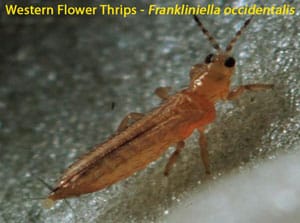|
|
BIOLOGICAL control of major insect pests such as Western Flower Thrips (WFT) has become possible now that new beneficial insects are available. Sending �good bugs� in to battle the pests has been part of a DAFWA project which has WFT as the prime target. Dr Sonya Broughton said integrated pest management using combinations of weapons was essential, as many pests were developing resistance to new pesticides in as little as three years. �Insecticides never achieve total control,� Dr Broughton said. ” Some insects always escape, Using a mix of tactics can work better as well as preserve the effectiveness of sprays for as long as possible. A new weapon for WA producers is a native bug called Orius armatus. �Orius was released commercially in September and is often combined with three other beneficial predators that prey on these different lifecycle stages,� Dr Broughton said. �Orius is a native species and its numbers vary in the wild. Rearing it in captivity and producing numbers sufficient to release into glasshouses has been a major achievement.� Dr Broughton said beneficial insects took time to build up and were not the instant fix that might be achieved with blanket spraying of chemicals. �WFT attacks more than 200 commercial plant species including lettuce and other vegetables, brassicas, strawberries, flowers, stonefruit and pomefruit,� she said.
WFT can also carry Tomato Spotted Wilt and other plant diseases which can devastate crops. WFT is difficult to control with pesticides as different lifecycle stages hid and fed in foliage and flowers, soil and leaf litter. WFT also develops resistance to sprays very quickly. �Sometimes growers still have to use pesticides, and timing is important so that chemicals do not wipe out the good guys as well as the bad,� she said. Source: Farm Weekly – 12 Jan 2010 |
|

